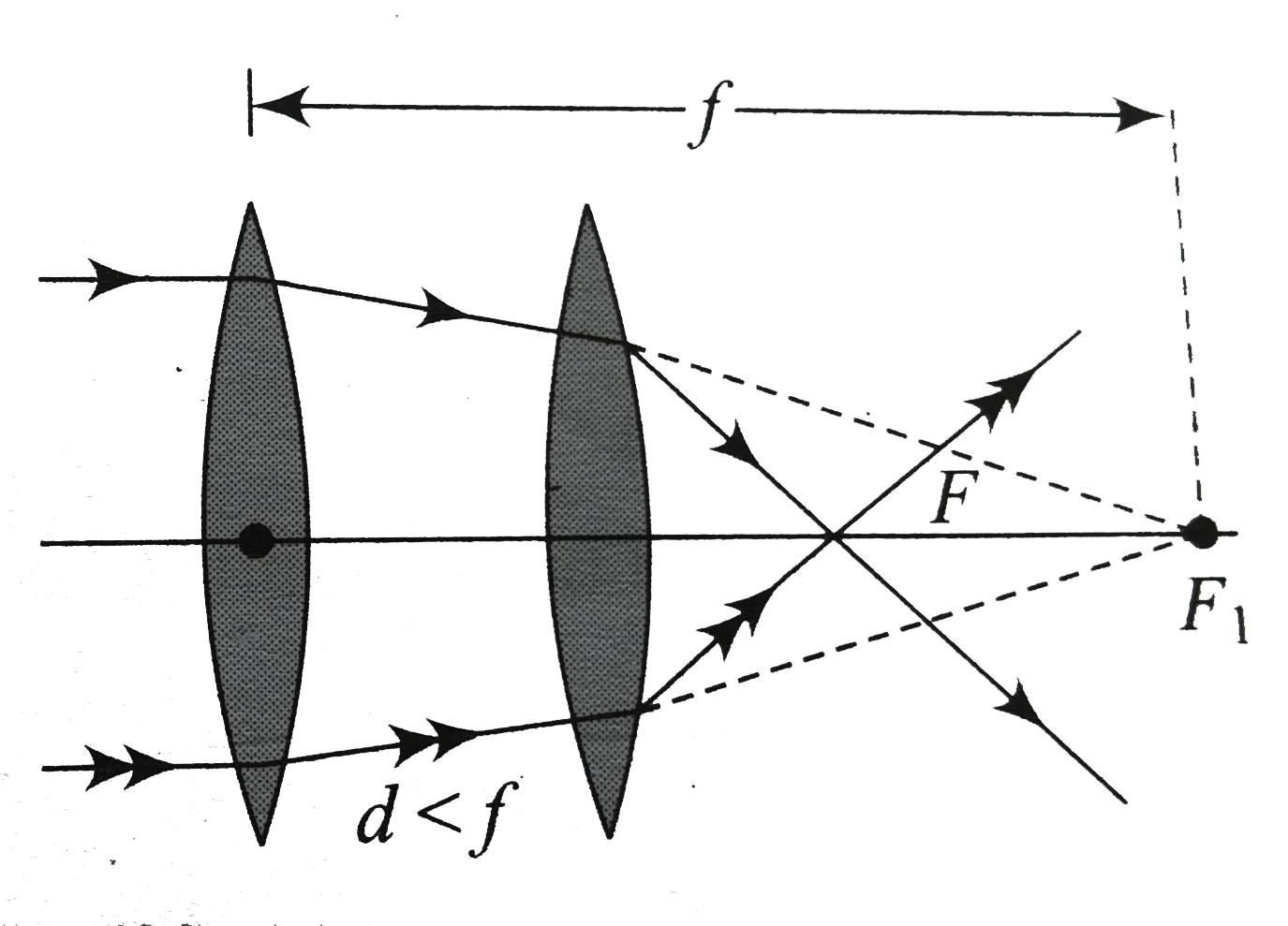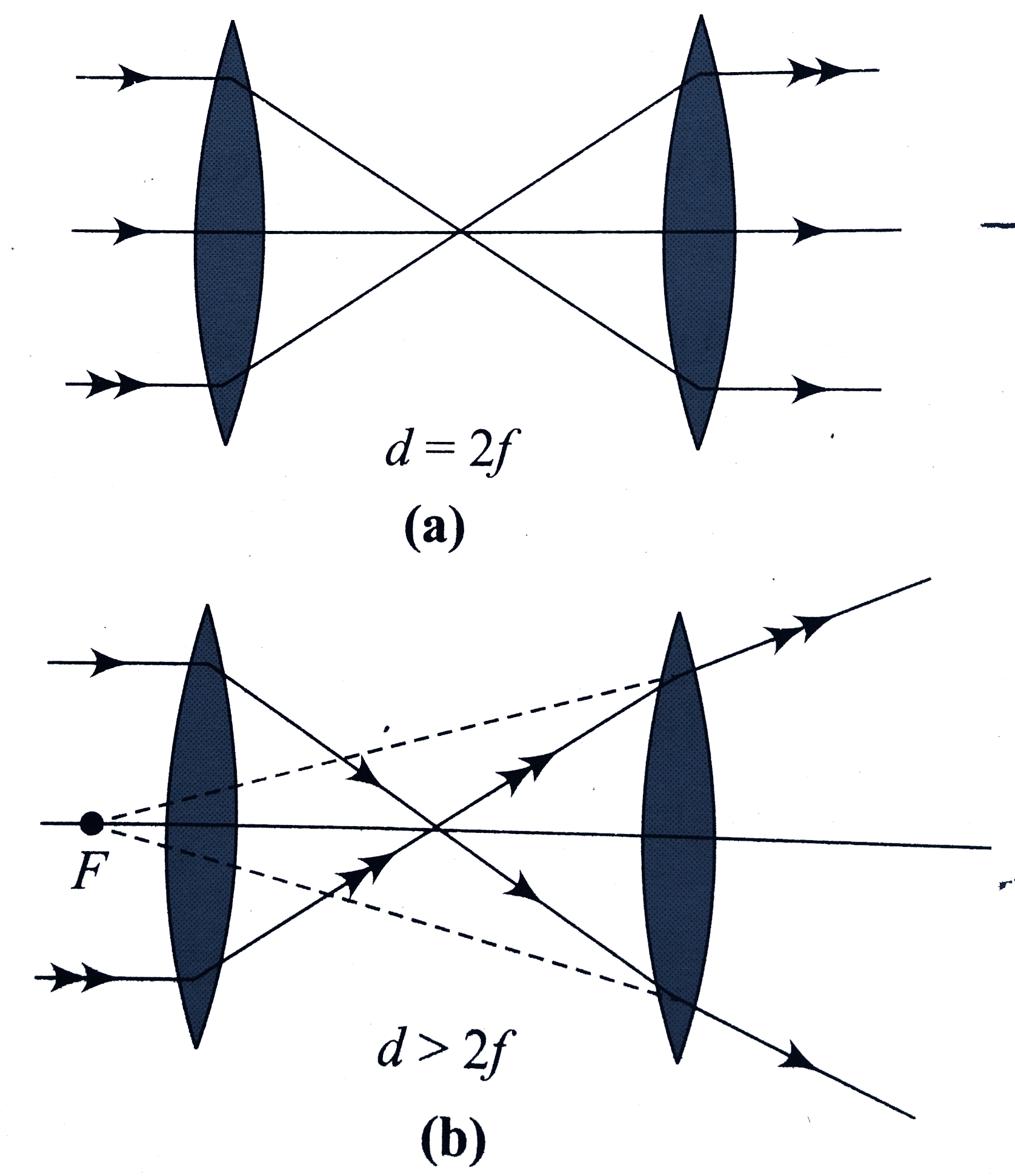Consider a coaxial system of two thin convex lenses of focal length f each separated by a distance d. Draw ray diagrams for image formation corresponding to an object at infinity placed on the principal axis in the following cases: (a) d<f,(b)d=f, (c ) f<d<2f, (d) d=2f, and (e) d>2f. Indicate the nature of the combination (concave, convex or plane) in each case.
In each of two thin lenses separated by a distance d, we have
1F=1f1+1f2−df1f2
For f1=f,f2=f,
1F=1f+1f−df2
F=f22f−d (i)
So, if d<f : F will be positive and >f. So, the system will behave as a convex lens of focal length<f as shown in Figure.
b. If d=f:F=f i.e., the system will behave as a convex lens of focal length f as shown in Figure
c. If f<d<2f : F will be positive and <f, so the system will behave as a convex lens of focal length >f as shown in Figure.
d. If d=2f : F will be indefinit, i.e., the system iwll behave as a plane glass plate of infinite focal length
If d>2f : F will become negative, i.e., the system will behave as concave lens as shown in Figure.




Topper's Solved these Questions
- GEOMETRICAL OPTICSBook:CENGAGE PHYSICSChapter:GEOMETRICAL OPTICSExercise:Solved Examples
Explore 15 Videos
- GEOMETRICAL OPTICSBook:CENGAGE PHYSICSChapter:GEOMETRICAL OPTICSExercise:Exercise1.1
Explore 14 Videos
- FRICTIONBook:CENGAGE PHYSICSChapter:FRICTIONExercise:QUESTION BANK
Explore 1 Video
- GRAVITATIONBook:CENGAGE PHYSICSChapter:GRAVITATIONExercise:Question Bank
Explore 39 Videos
Similar Questions
An object lies at a distance of 2f from a concave lens of focal length f. Draw a ray-diagram to illustrate the image formation.
View SolutionDraw neat and well labelled ray diagrams for image formation by a convex lens when an object is beyond 2F1
Also state the position , nature and size of the image relative to that of the object.
View Solution
Knowledge Check
Two convex lenses of focal lengths f1andf2 are separated co-axially by a distance d. The power of the combination will be one if
Ad=(f1+f2)−f1f2Bd=(f1−f2)+f1f2Cd=√f1f2..f1+f2Dd=(f1−f22)Two thin convex lenses of focal lengths f1 and f2 are in contact and coaxial. The power of the combination is
A√f1f2B√f2f1Cf1+f22Df1+f2f1f2Two convex lenses of focal length f1 and f2 are mounted coaxially separated by a distance. If the power of the combination is zero, the distance between the lenses is
A|f1−f2|Bf1+f2Cf1f2|f1−f2|Df1f2f1−f2
Draw neat and well labelled ray diagrams for image formation by a convex lens when an object is
at 2F1
View SolutionAn object is placed at a distance of f2 from a convex lens of focal length f. The image will be
View SolutionAn object is situated at a distance off/2from a convex lens of focal lengthfDistance of image will be-
View SolutionTwo thin lenses of focal lengths f1 and f2 are placed in contact with each other. The focal length of the combination is :
View SolutionTwo thin lenses of focal lengths f1 and f2 are placed in contact with each other. The focal length of the combination is :
View Solution